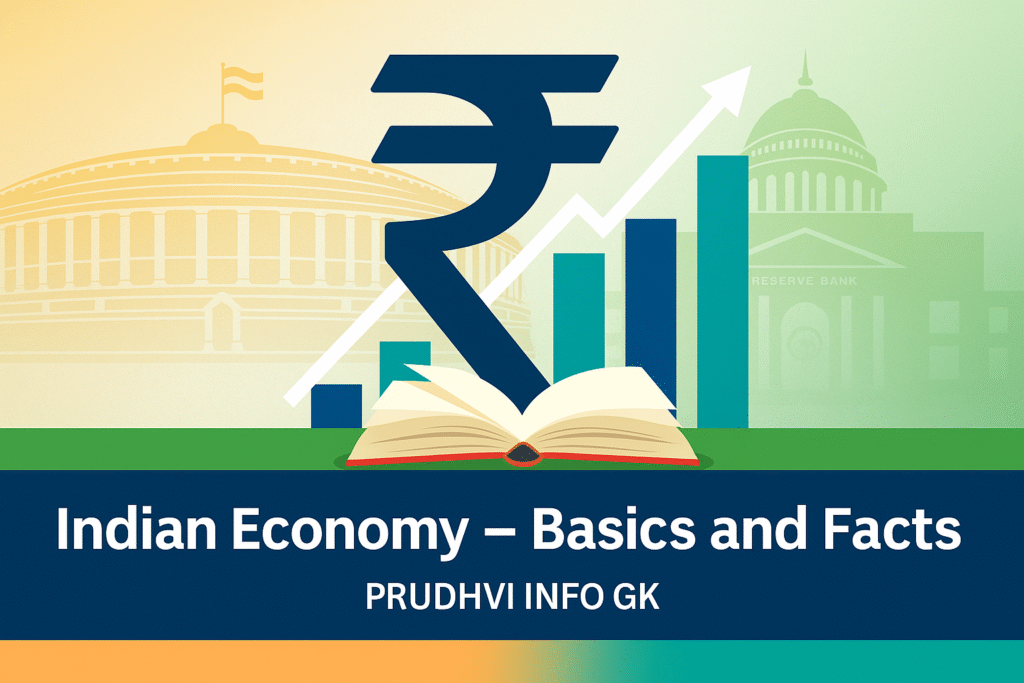
📌 Introduction
The Indian Economy is one of the largest and fastest-growing economies in the world. It is a mixed economy, combining features of both capitalism and socialism. Understanding its basics is essential for exams like UPSC, SSC, Banking, Railways, Defence, and State PSCs.
This article provides an overview of the structure, key sectors, economic concepts, and facts related to the Indian economy.
🏛️ Nature of the Indian Economy
- Mixed Economy: Combines public sector (government) and private sector (business & individuals).
- Agriculture-based but service-driven: Agriculture is still a backbone, but services contribute the most to GDP.
- Planned Development: Since independence, India has followed Five-Year Plans (1951–2017) and now uses NITI Aayog for planning.
- World Ranking: Among the top 5 economies globally in terms of GDP (nominal and PPP).
📊 Sectors of the Indian Economy
- Primary Sector (Agriculture & Allied Activities):
- Agriculture, forestry, fishing, mining
- Still employs nearly half of India’s workforce
- Secondary Sector (Industry & Manufacturing):
- Factories, construction, industrial production
- “Make in India” boosts this sector
- Tertiary Sector (Services):
- IT, banking, transport, education, healthcare
- Major contributor to India’s GDP (~55%+)
- Quaternary Sector (Knowledge Economy):
- R&D, information technology, consultancy, data services
- Quinary Sector (Decision-Making & Policy):
- Top executives, government leaders, policy framers
💱 Key Features of the Indian Economy
- Largest Democracy with Fast Growth: Huge domestic market
- Agricultural Backbone: Major producer of rice, wheat, cotton, spices, milk
- Service Dominance: IT, BPO, software exports lead globally
- Foreign Trade: Key exports → petroleum products, gems & jewellery, software, textiles
- FDI & Globalization: India is a major investment hub
- Demographic Dividend: Young workforce contributes to growth
📖 Important Economic Concepts
- GDP (Gross Domestic Product): Total value of goods & services produced within India
- GNP (Gross National Product): GDP + income earned by Indians abroad
- Inflation: Rise in prices of goods & services
- Deflation: Fall in prices
- Fiscal Deficit: Government’s expenditure > income
- Repo Rate: Rate at which RBI lends money to commercial banks
- Reverse Repo Rate: Rate at which RBI borrows money from banks
- CRR (Cash Reserve Ratio): Percentage of deposits banks must keep with RBI
- FDI (Foreign Direct Investment): Investment from foreign companies in Indian markets
- PPP (Purchasing Power Parity): Compares living costs between countries
🏦 Banking & Financial Institutions
- RBI (Reserve Bank of India): Central bank of India, established in 1935
- SEBI: Securities and Exchange Board of India (regulates stock markets)
- NABARD: Agriculture and Rural Development Bank
- SIDBI: Small Industries Development Bank
- IRDAI: Regulates insurance sector
📊 Key GK Facts
- First Five-Year Plan (1951–56): Focus on agriculture
- Green Revolution (1960s): Boosted food grain production
- Liberalization, Privatization, Globalization (LPG reforms): 1991 economic reforms opened India’s economy
- Current Planning Body: NITI Aayog (2015, replaced Planning Commission)
- Indian Currency: Rupee (₹), issued by RBI
- Largest employer in India: Agriculture sector
- Biggest contributor to GDP: Service sector
❓ FAQs
Q1. What type of economy is India?
👉 A mixed economy.
Q2. Which sector contributes most to India’s GDP?
👉 Service sector.
Q3. Who regulates the stock market in India?
👉 SEBI (Securities and Exchange Board of India).
Q4. When was the Reserve Bank of India established?
👉 1935.
Q5. What are LPG reforms?
👉 Liberalization, Privatization, Globalization (1991 economic reforms).
📌 Conclusion
The Indian economy is dynamic, growing, and diverse. From being an agriculture-driven economy, it has transformed into a service-led global powerhouse. For exams, focus on:
- Nature & sectors of the economy
- Key institutions (RBI, SEBI, NITI Aayog)
- Important terms (GDP, FDI, Inflation, Repo Rate, etc.)
- Historic milestones (Green Revolution, LPG reforms, Five-Year Plans)
📢 Follow Prudhvi Info GK
👉 WhatsApp Channel: Follow PRUDHVI INFO on WhatsApp
👉 Instagram: Prudhvi Info on Instagram
👉 Facebook: Prudhvi Info on Facebook
👉 Twitter (X): Prudhvi Info on X


